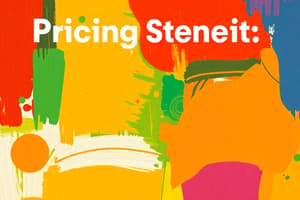Podcast
Questions and Answers
Which of the following is NOT one of the Four P's of marketing?
Which of the following is NOT one of the Four P's of marketing?
- Payment (correct)
- Product
- Promotion
- Price
Higher demand for a product generally allows for lower prices.
Higher demand for a product generally allows for lower prices.
False (B)
What is the primary purpose of the promotion mix?
What is the primary purpose of the promotion mix?
To communicate the value of the product to the target audience
The __________ channel involves the manufacturer distributing products directly to customers without intermediaries.
The __________ channel involves the manufacturer distributing products directly to customers without intermediaries.
Match the pricing factors with their descriptions:
Match the pricing factors with their descriptions:
Which component of physical distribution is crucial for customer satisfaction?
Which component of physical distribution is crucial for customer satisfaction?
Indirect channels are typically used for selling perishable goods.
Indirect channels are typically used for selling perishable goods.
Name one key tool in the promotion mix.
Name one key tool in the promotion mix.
The __________ level represents the quantity of product maintained in stock.
The __________ level represents the quantity of product maintained in stock.
What is one benefit of a higher inventory level?
What is one benefit of a higher inventory level?
Flashcards
Product
Product
The tangible good or service offered to the market.
Price
Price
The amount of money customers pay for a product.
Place
Place
Distribution channels used to reach customers.
Promotion
Promotion
Signup and view all the flashcards
Direct Channel
Direct Channel
Signup and view all the flashcards
Indirect Channel
Indirect Channel
Signup and view all the flashcards
Order Processing
Order Processing
Signup and view all the flashcards
Transportation
Transportation
Signup and view all the flashcards
Advertising
Advertising
Signup and view all the flashcards
Personal Selling
Personal Selling
Signup and view all the flashcards
Study Notes
Marketing: The Four P's
- Product: The tangible good or service the company is offering to the market.
- Price: The amount of money customers pay for the product.
- Place: The distribution channels used to reach customers.
- Promotion: Efforts to communicate the value of the product to the target audience.
Factors that Determine Price
- Production Cost: The cost of manufacturing or producing the product.
- Competitor Analysis: Analyzing prices and strategies of competitors in the market.
- Utility and Demand: The level of demand for the product. Higher demand often allows for higher prices.
- Government and Legal Regulations: Specific rules and regulations set by government agencies regarding pricing, especially for essential goods.
- Marketing Methods: The cost and strategies used for promoting the product.
- Company Objectives: Whether the company prioritizes profit maximization, market share capture, or quality.
Channels of Distribution
- Direct Channel (Zero Level): The manufacturer directly distributes the product to customers without any intermediary.
- This is often used for perishable goods, expensive items, or complex and customized products.
- Indirect Channel: The manufacturer uses intermediaries like wholesalers and retailers to reach customers. Different levels of intermediaries can be involved, with one, two, or three levels between the manufacturer and the final customer.
- This is commonly used when targeting a wider market or selling non-perishable, non-customized products.
Components of Physical Distribution
- Order Processing: The speed and accuracy of fulfilling customer orders are crucial for customer satisfaction.
- Transportation: The method of transporting the product from the manufacturer to the customer, considering considerations like cost, speed, and product sensitivity.
- Warehousing: The storage facilities used to hold the product, considering the level of inventory needed for efficient customer service.
- Inventory Level: The quantity of product maintained in stock. Higher inventory levels allow for faster delivery, but require significant working capital.
Promotion Mix: Four Key Tools
- Advertising: Paid, impersonal communication through various media channels to promote products or services.
- Personal Selling: Direct, one-on-one interaction between a salesperson and a customer to establish a relationship and sell the product.
- Sales Promotion: Short-term incentives for purchasing and encouraging sales, like discounts, giveaways, bundle deals, or contests.
- Public Relations: Building positive relationships with the public and building a favorable image for the company and its products, through press releases, community involvement, and other public communications strategies.
Studying That Suits You
Use AI to generate personalized quizzes and flashcards to suit your learning preferences.




